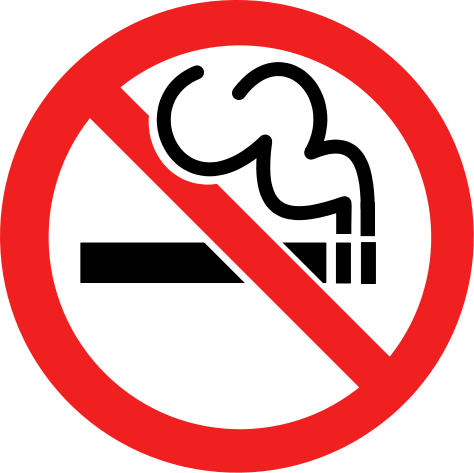Everyone knows that smoking kills, yet smoking is still painfully present on the University of Rochester campus. While the University has a ban on smoking within 30 feet from building entrances, this policy is rarely followed and is never enforced. For non-smoking students, this results in exposure to secondhand smoke, the negative health effects of which are well documented. For smoking students, this creates an environment that does nothing to discourage smoking and that does little to support efforts to quit. While thousands of universities across the country ban smoking on their campuses, Rochester is turning a blind eye to the issue of smoking on campus and is allowing students’ health to suffer.
The dangers of secondhand smoke are scientifically founded, yet I have heard many students argue that smokers on campus don’t really harm other students here; people often claim that simply walking by a smoker a few times a day won’t hurt anyone. But there are no safe levels of secondhand smoke exposure – this means that any exposure to secondhand smoke is harmful. In fact, since 1964 over 2,500,000 nonsmokers have died from causes related to secondhand smoke exposure. In adults who have never smoked, secondhand smoke exposure can cause stroke, lung disease, and heart disease. Even for nonsmokers, breathing in secondhand smoke has immediate negative effects on blood vessels and the heart.¹
Additionally, smoking and the use of tobacco products has a negative effect on the environment. Cigarettes butts are non-biodegradable, and as 1.69 billion pounds of butts are discarded yearly worldwide, they pose a significant threat to wildlife, particularly aquatic ecosystems. The chemicals that leach out of cigarette butts are toxic to fresh-water microorganisms, and cigarette butts can be poisonous when ingested by other animals.² Each year, thousands of marine animals are sickened or killed by garbage in their environments, including cigarette butts. Cigarettes also contain small amounts of radioactive material, which is released into the environment via smoking and is absorbed into the earth and waterways when cigarette butts are left on the ground.³ As made obvious by the name, the River Campus is situated right against the Genesee River, which in 2012 was ranked the 32nd most polluted river in the United States. As an aquatic ecosystem, cigarette litter from our campus can do nothing but impact the Genesee negatively. A ban of smoking on campus would be an important step towards furthering the University’s sustainability and environmental-friendly practices.
Not only would the University save face, environmentally speaking, by banning smoking, but would also stand to benefit economically as well. Cleaning up cigarette butts costs money, and according to Patricia Beaumont, Director Facilities Support Operations, that cost is “significant,” and the work involved in the clean up is “more than a full-time job.” So while there may be some economic concerns regarding the expenses involved in going smoke free, there is certainly money to be saved by making such a change.
The idea of making the University of Rochester smoke free is not a new one. There have been many student-led initiatives to ban smoking in the past. In a meeting with the executive board of the Society of Undergraduate Public Health Students on January 27th, Tristan Ford explained that his initial plan to get smoking banned involved bringing the issue to the student senate. However, he found it difficult to push the issue through senate, and realized that ultimately the decision would fall to University leadership. Accordingly, Tristan then brought together researches and staff from the University, including Dr. Macintosh, who studies smoking cessation and was involved in the successful push for the Medical Center to become smoke free; Dr. Chin, a public health anthropologist involved in global smoking cessation research; and Linda Dudman, who works in the Health Promotion Office of University Health Services. Ultimately, these efforts have been unsuccessful, due to numerous cultural and economic factors.
Currently, though, a renewed push for a smoke free campus is being made. Thanks to the interest of Niru Murali, Executive Director of Student Life for SA Government and a public health student at the University, more students are coming together to support the efforts that Tristan started years ago. Through Niru’s efforts and under Tristan’s guidance, the Society of Undergraduate Public Health Students (SUPHS) have become involved, and are seeking to spearhead a committee of interested students to work with the Health Promotion Office to make a joint push towards a smoke free campus. Having decided with Tristan that the best approach at the moment would be to present a unified student front, SUPHS is currently reaching out to student organizations to garner support for such a committee, and to ultimately build support for a ban on smoking. Additionally, Niru has created a petition on the SA government website IMPACT, which, if 250 signatures are reached, will be presented to the senate.
This is a topic that students are passionate about, and rightfully so. As stated by Joseph Glick, President of SUPHS: “We’ve known for decades that secondhand smoking is harmful to our health. Even brief expose has nearly the same health effects as actively smoking. By banning smoking, we not only greatly improve the health of those who actively smoke, but also improve the health of every University student, staff member, and visitor.”
Written by Ciara McGillivray, class of 2018
Sources:
- http://www.cdc.gov/tobacco/data_statistics/fact_sheets/secondhand_smoke/general_facts/index.htm
- http://tobaccofreeca.com/smoking-problem/impact/environment/
- http://www.ash.org.uk/files/documents/ASH_127.pdf
Photo source: https://commons.wikimedia.org/wiki/File:New_no_smoking.svg

